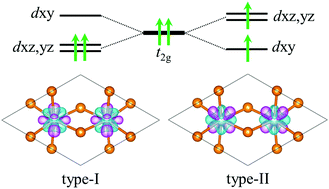Discovery of twin orbital-order phases in ferromagnetic semiconducting VI3 monolayer†
Abstract
Spontaneous orbital symmetry breaking in crystals gives rise to abundant novel and interesting physical properties, which sometimes are concealed by the absence of geometrical distortions. We show that a recently discovered 3d2 system, namely the layered VI3 ferromagnetic semiconductor, is a strongly correlated and orbital ordering system. Our analysis reveals that in a VI3-like system, there could be two types of orbital splitting, which are stabilized respectively by strong electronic correlation and inter-atomic exchange interactions. Consequently, on the basis of first-principles calculations, two competing low-energy phases of VI3 monolayer (denoted as twin orbital-order phases) are discovered, in which the metal–insulator transition is driven by strong electronic correlation, and the orbital symmetry breaking is robust against geometrical distortions. In addition, similar phenomena are also observed in other VI3-like systems. These findings shed light on the unusual electronic behavior of a strongly correlated 2D system and will be interesting for nanoscale multi-functional spintronic applications.

- This article is part of the themed collection: 2019 PCCP HOT Articles


 Please wait while we load your content...
Please wait while we load your content...
